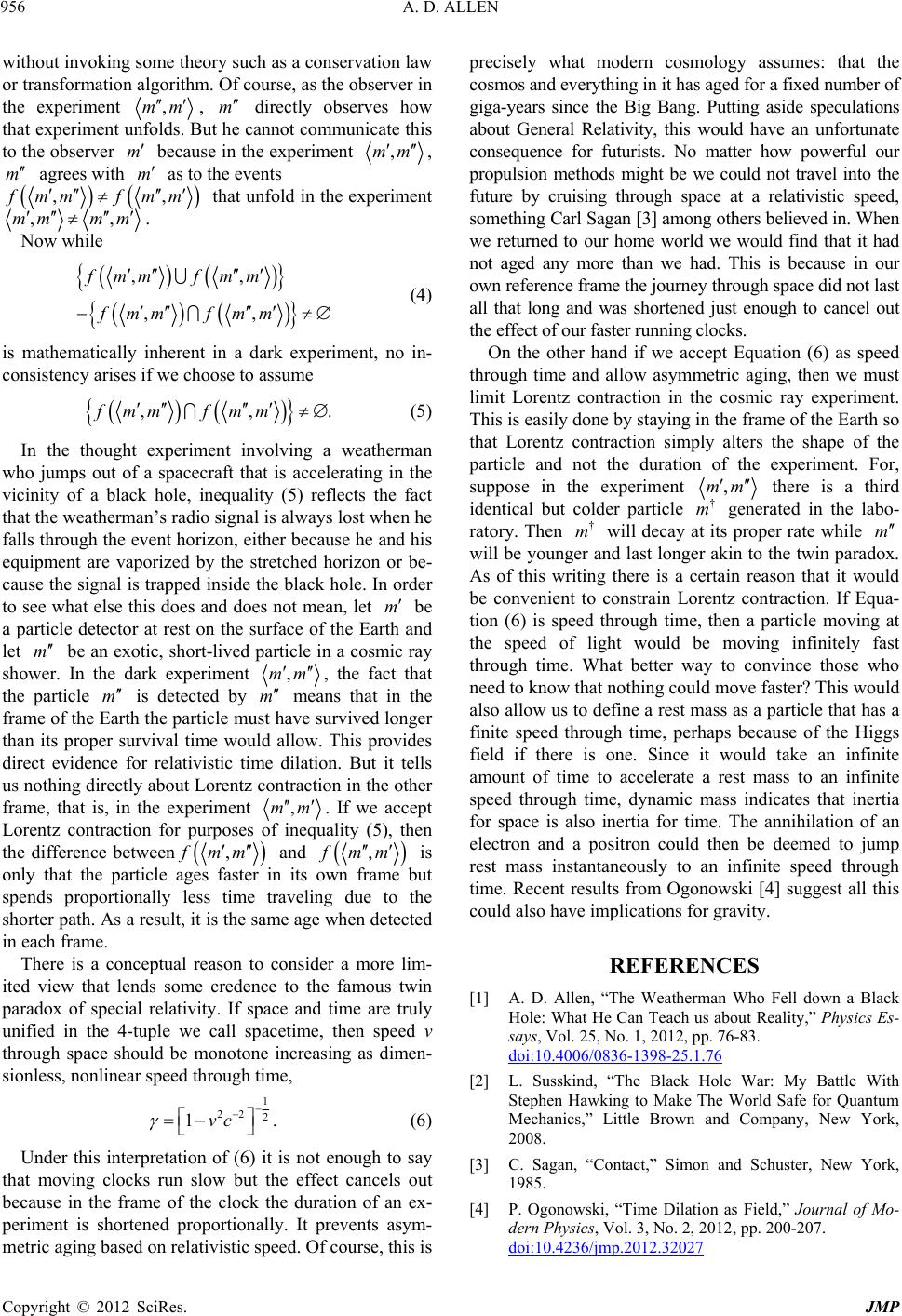
A. D. ALLEN
956
without invoking some theory such as a conservation law
or transformation algorithm. Of course, as the observer in
the experiment ,mm
m
,
m
directly observes how
that experiment unfolds. But he cannot communicate this
to the observer because in the experiment ,mm
m m,
agrees with as to the events
,,
mm
f mm
that unfold in the experiment
,,mm
mm
.
Now while
,,
m
m
,,fmm fm
fmm fm
(4)
is mathematically inherent in a dark experiment, no in-
consistency arises if we choose to assume
,.mm
m
,fmm f
(5)
In the thought experiment involving a weatherman
who jumps out of a spacecraft that is accelerating in the
vicinity of a black hole, inequality (5) reflects the fact
that the weatherman’s radio signal is always lost when he
falls through the event horizon, either because he and his
equipment are vaporized by the stretched horizon or be-
cause the signal is trapped inside the black hole. In order
to see what else this does and does not mean, let
be
a particle detector at rest on the surface of the Earth and
let be an exotic, sh ort-lived particle in a cosmic ray
shower. In the dark experiment
m
,mm
m , the fact that
the particle is detected by m means that in the
frame of the Earth the particle must have survived longer
than its proper survival time would allow. This provides
direct evidence for relativistic time dilation. But it tells
us nothing directly about Lorentz contraction in the other
frame, that is, in the experiment ,mm
. If we accept
Lorentz contraction for purposes of inequality (5), then
the difference between
,fmm
and
,
mm
is
only that the particle ages faster in its own frame but
spends proportionally less time traveling due to the
shorter path. As a result, it is the same age when detected
in each frame.
There is a conceptual reason to consider a more lim-
ited view that lends some credence to the famous twin
paradox of special relativity. If space and time are truly
unified in the 4-tuple we call spacetime, then speed v
through space should be monotone increasing as dimen-
sionless, nonlinear speed through time,
1
22 2
1.vc
(6)
Under this interpretation of (6) it is not enough to say
that moving clocks run slow but the effect cancels out
because in the frame of the clock the duration of an ex-
periment is shortened proportionally. It prevents asym-
metric aging based on relativistic speed. Of course, this is
precisely what modern cosmology assumes: that the
cosmos and everything in it has aged for a fixed number of
giga-years since the Big Bang. Putting aside speculations
about General Relativity, this would have an unfortunate
consequence for futurists. No matter how powerful our
propulsion methods might be we could not travel into the
future by cruising through space at a relativistic speed,
something Carl Sagan [3] among others believed in. When
we returned to our home world we would find that it had
not aged any more than we had. This is because in our
own reference frame the journey through space did not last
all that long and was shortened just enough to cancel out
the effect of our faster running clocks.
On the other hand if we accept Equation (6) as speed
through time and allow asymmetric aging, then we must
limit Lorentz contraction in the cosmic ray experiment.
This is easily done by staying in the frame of the Earth so
that Lorentz contraction simply alters the shape of the
particle and not the duration of the experiment. For,
suppose in the experiment ,mm
†
m
†
mm
there is a third
identical but colder particle generated in the labo-
ratory. Then will decay at its proper rate while
will be younger and last longer akin to the twin paradox.
As of this writing there is a certain reason that it would
be convenient to constrain Lorentz contraction. If Equa-
tion (6) is speed through time, then a particle moving at
the speed of light would be moving infinitely fast
through time. What better way to convince those who
need to know that nothing could move faster? This would
also allow us to define a rest mass as a particle that has a
finite speed through time, perhaps because of the Higgs
field if there is one. Since it would take an infinite
amount of time to accelerate a rest mass to an infinite
speed through time, dynamic mass indicates that inertia
for space is also inertia for time. The annihilation of an
electron and a positron could then be deemed to jump
rest mass instantaneously to an infinite speed through
time. Recent results from Ogonowski [4] suggest all this
could also have implications fo r gravity.
REFERENCES
[1] A. D. Allen, “The Weatherman Who Fell down a Black
Hole: What He Can Teach us about Reality,” Physics Es-
says, Vol. 25, No. 1, 2012, pp. 76-83.
doi:10.4006/0836-1398-25.1.76
[2] L. Susskind, “The Black Hole War: My Battle With
Stephen Hawking to Make The World Safe for Quantum
Mechanics,” Little Brown and Company, New York,
2008.
[3] C. Sagan, “Contact,” Simon and Schuster, New York,
1985.
[4] P. Ogonowski, “Time Dilation as Field,” Journal of Mo-
dern Physics, Vol. 3, No. 2, 2012, pp. 200-207.
doi:10.4236/jmp.2012.32027
Copyright © 2012 SciRes. JMP